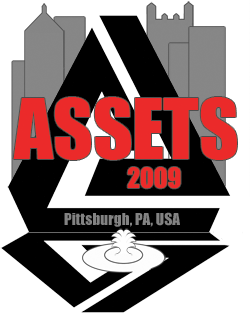February 2009 Archives
Amazon's Kindle is really cool. The potential of Kindle is huge, despite currently being priced woefully beyond the budget of most grad student mortals. Access to millions of books on a readable screen all from the palm of your hand - fantastic!
The original Kindle used only a visual display, which irked many potential blind users. It's been shown that blind folks buy an average of 7 times more books than sighted people, so it might also not have been the best business decision on Amazon's part. The Kindle 2 (partially) rectifies this situation - it adds TTS to the device so that it can read its electronic books to people. The interface still isn't accessible without vision - but it's potentially of incredible use for people with low-vision, or someone walking down the street who doesn't want to run into street signs.
Enter the Author's Guild.
The Author's Guild is suing Amazon because they feel that the device infringes on their copyright restrictions - they like to sell copyright piecemeal, assigning copyright separately to print and audio. That's all well and good when someone is actually performing the audio reading.
Claiming that an individual cannot have a system they own read a book that they have purchased is plain ludicrous. I have long been able to purchase a book, scan it in, OCR it, and then send that to a TTS system to be read to me. How is this different than me reading a book that I purchased to my child?
The National Federation of the Blind has correctly railed against the suit to which Roy Blount Jr., Author's Guild President, has responded that exceptions are already made for people with disabilities. The point isn't that this would prevent someone with a full disability from accessing material that they purchased in a form more convenient to them, but that (i) it would prevent them from doing it easily (without having a doctor's note for instance) and (ii) would prevent the much larger population of people who find it difficult to read printed material but do not have (or could not get) the appropriate doctor's note.
Roy obviously doesn't understand the issues, and is trying to play the little guy in today's opinion piece for the New York Times. Yes, Roy, people are claiming that automatically-produced, natural-sounding speech is right around the corner for decades. Yes, Roy, people with disabilities can, with non-trivial effort, work around copyright restrictions. No, this is nothing new - you can do this with most computer-based eBook readers. Oh, and, no, making voices sound female and male does not represent even close to the variation required to make these voices pleasant to listen to.
The problem the Authors' Guild has is one of failing to adapt to new technology. Stop punishing the little guy!

A call recently went out for the mentoring program at ASSETS. Have a great idea that you think could form an excellent contribution to the conference but not quite sure how to write it up and target that contribution to the ASSETS audience? Sign up for a mentor who can help guide you through this process! Are you an experienced ASSETS contributor looking to give back to the community and help some newer folks make their first contribution? Sign up to be a mentor!
The mentoring page, including sign up forms, is located here:
Mentoring Page
There's a myth in academia that research is inherently only pure or applied. The reality is much more complex. Accessibility research in particular is sometimes dismissed because of a misunderstanding of this issue. Scientists will dismiss it as research because there is an obvious application and social application, leading folks to say "What you're doing is so great for people, but I just don't see how it's research." Accessibility folks who want to get new helpful technology out to users often criticize research as having no impact. As researchers, we should be striving for both -- only by releasing technology to at least a few users can we truly motivate our work, but we should always be pushing the boundaries of what is possible. And sometimes that means our work won't be developed to the point where it's appropriate to used by ordinary users for day-to-day activities. It's a delicate balance to make, but it's not an either-or situation.
This post was brought about because of an article in the New York Times today, discussing this trade-off in science in general:
For those who are interested, you might also read the excellent book Pasteur's Quadrant by Donald E. Stokes, which considers how this issue has evolved over the past few years.
 WebAIM recently released the results of a massive survey of more than 1000 screen reader users that it conducted in November/December of 2008. The results are very interesting, and I'll likely revisit them in a later post. For now, go check out the WebAIM Survey of Screen Reader Users.
WebAIM recently released the results of a massive survey of more than 1000 screen reader users that it conducted in November/December of 2008. The results are very interesting, and I'll likely revisit them in a later post. For now, go check out the WebAIM Survey of Screen Reader Users.
 ASSETS is the premier venue academic technology conference for accessibility research. The submission deadline for full technical papers is May 10 and poster/demonstration submissions are due July 6th. Check out the ASSETS 2009 website for more information!
ASSETS is the premier venue academic technology conference for accessibility research. The submission deadline for full technical papers is May 10 and poster/demonstration submissions are due July 6th. Check out the ASSETS 2009 website for more information!I'm also the webmaster (and creator of the sweet graphic above).
